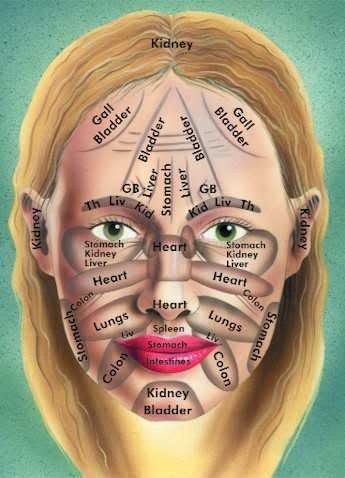Your face can reveal a lot about your lifestyle, from bad digestion to low iron levels, according to health and beauty experts.
While sophisticated MRI and X-Ray machines leave little to the imagination, they haven’t been around that long. Human disease and disorders, however, precede them by millennia. Instead, ancient medical practitioners have used nuanced observational diagnoses to quickly narrow down symptoms to specific imbalances within the body and help prevent or correct future disease.
The same techniques can still be used today to read the skin on your face to help determine what’s causing flare-ups or blemishes. “Face mapping,” an ancient practice rooted in Ayurvedic teaching, connects a point on your face to an organ or body part so you know what to treat internally for clear external results.
Here are the areas your face may be breaking out or experiencing an issue, and what they say about your health:
Forehead
Might mean: gallbladder and liver issues
According to Ayurveda, the forehead is ruled by the Vata dosha and relates to the nervous system and digestive system, meaning stress and internal stagnation are probably causing breakouts here. Try reducing the amount of processed foods and fat in your diet sure to eat less processed foods, while incorporating meditation and yoga to keep stress low.
Horizontal lines on the forehead:
This may indicate digestive issues. They can be combated by drinking warm water mixed with lemon juice first thing every morning.
A pronounced frown line: A pronounced line between the eyes shows the liver is under pressure. This could be for physical, environmental and emotional reasons, an allergy to foods/substances or loss and grief. This leads to adrenal overload, known as burnout. Try gently massaging the area with circular moves.
Pimples on the forehead: This could indicate internal symptoms, such as problems with the liver and stomach congestion. Drink plenty of water to flush out any toxins. You should also eat more liver-friendly foods, such as leafy green vegetables, and cut out processed foods, as well as caffeine.
Between eyebrows, right side
Might mean: repressing emotions in your liver
It’s apparent to most that deep seated anxiety would cause your lovely face to wrinkle up, but understanding the line pattern can help you understand where you might be holding stress and which of your organs may consequently be most at risk. If you have a vertical line between your eyebrows on the right side, it indicates you’re repressing emotions – especially anger – in your liver.
Between eyebrows, left side
Might mean: repressing emotions in the spleen
A line on the left side indicates that emotions are likely penned up in the spleen.
Eyes
Might mean: joint problems, intestinal issues, thyroid problems
Eyes can be particularly telling: Small irises point to joint problems and an increased whiteness in the iris can indicate that joints are in a degenerative state. A spotty iris can mean poor nutrient absorption in the intestine. If you observe a light ring around the iris, cut back on your sugar and salt intake as this indicates that you have an excess of both. A yellowish color in the eye can indicate a weak liver.
Below eyes
Might mean: impaired kidney function
Puffiness and swollen lower eyelids indicate impaired kidney function.Increasing water intake will help, as will measures that kindle the body’s digestive fire, such as adding more spices to your food and making sure to chew your food well. (Ayurveda recommends chewing each morsel nearly 30 times before swallowing!)
Dark circles under the eyes: Dark circles that persist despite regular and restful sleep may be a result of food intolerances. Sufferers should remove dairy and wheat from their diet and see if the circles lighten. Another culprit is alcohol – even in moderate amounts this can cause darkness around the eyes. Try to reduce alcohol consumption.
Dark circles on the eyes: This indicates a possible deficiency of iron in the blood. “Try reducing the amount of stimulating drinks you have, including fizzy drinks, coffee and tea.
White spots on the eyes: A series of white spots near the outer rim can indicate a chronic congestion of the lymphatic system. You should avoid lactose and cow’s milk products.

Cheeks
Might mean: slow metabolism, low absorption of nutrients, lung issues
Patchiness or discoloration on the cheeks can indicate poor metabolism and low absorption of nutrients, such as folic acid and iron. Additionally, cheeks are linked to lung function (think about how red your face gets during a strenuous workout that has you breathing hard), so pay attention to the quality of your breath and consider breathing exercises.
Not based in Ayurveda, but it’s important to note that acne on the cheeks might be caused by a dirty cellphone and pillowcases, or a tendency to touch your face a lot. Make sure to keep your hands away from your face, and accessories and sheets clean.
Spots on the cheeks:
“These can be caused by not cleaning foundation away properly so the skin becomes congested,” Helen Ambrosen, co-founder and product inventor of Lush cosmetics company, says. “This might be from using a water-based cleanser that doesn’t remove make-up fully. Use an oil-based cleanser and take a break from wearing make-up to let the skin breathe.”
Nose
Might mean: blood and heart issues
Because the cheeks and nose are governed by the Pitta dosha (the fire element), it’s no surprise that breakouts here indicate an internal flare up. The nose is closely related to your circulatory system, so if you find yourself breakout out there, it might indicate a blood pressure issue. Up the amounts of essential fatty acids in your diet (avocado, flax, olive oil), and avoid alcohol, coffee and spicy foods.
Ears & Jawline
Itchy ears: Itchy ears are often the sign of an allergy or low tolerance. Psoriasis and eczema here are signs that the person is depleted in vitamin D – the sunshine vitamin. Spending 10 minutes with the arms and face exposed will give the body vital sunshine and plenty of vitamin D.
Acne on the jawline: Acne here may result from eating lots of dairy, sugar and refined foods, such as burgers, chips, crisps and fizzy drinks. Eat more fresh foods and replace fizzy drinks with water to flush out toxins. Ensure the affected areas are cleansed thoroughly.
Acne around the jawline:
“Oestrogen is a friend to our skin, suppressing sebaceous activity, but when levels reduce as women get older, skin lacks lustre and you may experience acne cysts deep in the dermis and commonly found on the jawline and hairline,” dermatologist Dr Howard Murad says. “Try eating apricots, shiitake mushrooms, sweet potatoes, and mangos as they all contain vitamin A to normalise the production and life cycle of skin
Mouth & Chin
Lines around the mouth:
“A primary concern for many women is ageing lines around the mouth, which can be caused by smoking,” beauty and nutritional therapist Jennifer Young says. “The effects can be lessened by regularly applying lip balm.” And quitting smoking, of course.
Sores around the mouth:
“Sores in the corner of the mouth may indicate a deficiency of B vitamins,” skin expert and facialist Nataliya Robinson says. “Try introducing more whole grains into your diet, along with green vegetables and meat – all are full of vitamin B. Alternatively, you could try taking a vitamin B supplement.”
Chin might mean: Hormonal imbalance
Your chin is most likely where hormonal imbalances and stress will make themselves known, which means you’re more likely to break out there around your menstrual cycle. Reducing stress as much as possible, getting adequate sleep and exercising will help heal blemishes around this Kapha dosha-ruled area.
Lower lip
Might mean: intestines, digestions
Your lower lip can provide key insights into the functioning of your intestines. Browns spots can mean you may be suffering from indigestion and poor enzyme function, as well as a possibility of parasites or worms in the lower intestine. Adding more probiotics to your diet may help.
Pale lips are often the first sign of anemic onset, so increase your intake of leafy greens and other iron-rich foods. If you’re noticing a distinct bluish tinge on your lips, it may indicate poor oxygen absorption – possibly even a heart condition — and if you’re experiencing breathlessness that goes with it, you definitely want to follow up with your doctor. Finally, discoloration on the lower lip could indicate a possible disorder in the intestines, while discolorations on the edges of your lips may indicate a kidney issue.
Tongue
Might mean: toxin buildup, lung issues
Your tongue is the first place many internal disorders will show up, so you’ll want to inspect it every day (preferably in the mornings). Circular white residue in the middle or the back of the tongue indicates a build up of toxins in the intestines or colon, meaning it might be time for a detox.
Frothiness or abrasions at the edges of your tongue indicate a possible issue with the lungs, meaning aerobic exercise and meditation are especially important for you. If you find the outer edge of your tongue looking ridged or uneven, that would indicate poor absorption of nutrients into your blood stream. This could be happening because you’re eating too many processed foods, and sometimes even due to the overuse of vitamins (counterintuitive, I know!). Focus on clean, whole foods high in vitamins, iron and folic acids.
Skin
Small bumps under the skin: You may be using too strong a product on the skin. Make sure you’re choosing the right cleanser. A milder one would be more suitable if you suffer from this.
Dark patches: These can be caused by medication or illness so be sure to discuss it with your doctor. Age spots, on the other hand, may be the body’s way of ridding itself of toxins. Eat more fresh foods, drink more water and massage a small amount of castor oil on to existing age spots.
Oily skin: Oily skin can be caused or worsened by your diet. Pay attention to your diet. As you get older, your skin produces less sebum. Choose the right cleanser to keep it under control and use a face mask regularly.
Puffy skin: The skin may be trying to protect itself from a beauty product that’s too strong for it. Drink lots of water to help drain the lymph system.
Elsewhere on your head…
Sore throats and ulcers: If you get these regularly, it could be a sign of a gum infection. Mouth ulcers can indicate a suppressed immune system, so rest and eat well. If it lasts longer than a fortnight, see a GP.
Bad breath: This can indicate liver disease and digestive disorders, but first check teeth and gums are in good health and avoid garlic-heavy meals (chewing parsley can minimise garlic breath).
Dry mouth: This may just mean you’re dehydrated, but if it’s always dry and you don’t smoke or aren’t on medication, it could be a sign of diabetes.
Yellow teeth: Discoloured teeth can be due to drinking too much tea and coffee, or smoking. Some antibiotics can also cause teeth to yellow.
Dull, brittle hair: Treated locks may just need TLC, but brittle hair can mean you’re low in protein. A diet rich in iron and essential fatty acids will also help keep it strong. Limp or rapidly thinning hair can indicate thyroid issues, so see a GP.


